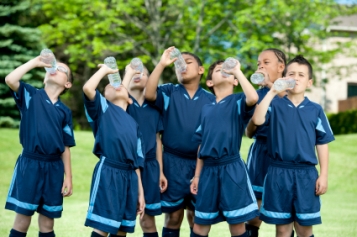Exertional heat illness among youth athletes is preventable so long as coaches, parents and other adults take common sense precautions, says the American Academy of
Pediatrics in a new report.1
Risk factors
- Hot and/or humid conditions (remember, however, that exertional heat illness, including heat exhaustion and heat stroke, can occur even if it isn't hot and humid);
- Poor preparation
- Not heat-acclimatized
- Inadequate prehydration
- Little sleep/rest
- Poor fitness
- Excessive physical exertion
- Insufficient rest/recovery time between repeat bouts of high-intensity exercise (e.g. repeat wind sprints)
- Insufficient rest/recovery time between repeat bouts of high-intensity exercise (e.g. repeat wind sprints)
- Insufficient access to fluids and opportunities to rehydrate;
- Multiple same-day sessions
- Insufficient rest/recovery time between practices, games, or matches
- Insufficient rest/recovery time between practices, games, or matches
- Obesity (BMI ≥ 85th percentile for age)
- Chronic illnesses, including
- diabetes insipidus
- type 2 diabetes mellitus
- juvenile hyperthyroidism (Graves disease)
- cystic fibrosis
- Other chronic or acute medical condition or injury that adversely affects water-electrolyte balance, thermoregulation, and exercise-heat tolerance;
- Anticholinergic drugs or certain medications that affect hydration or thermoregulation (e.g. a dopamine-reuptake inhibitor used to treat attention-deficit/hyperactivity disorder or performance enhancing drugs or diuretics);
- Current or recent illness, especially if it involves/involved gastrointestinal distress (e.g. vomiting, diarrhea) and/or fever;
- Clothing, uniforms, or protective equipment that contribute to excessive heat retention (football/lacrosse helmets, football shoulder pads, field hockey/lacrosse goalie equipment);
- Sickle cell trait (exertional sickling)
Prevention tips
Among the prevention measures recommended by the AAP for reducing the risk of heat illness are to:
- Provide risk-reduction training for coaches, trainers and other adults;
- Ensure that trained staff and facilties (e.g. ice-water baths) are available on-site to monitor for and promptly treat heat illness.
- Educate children about the importance of proper preparation, ample hydration, honest reporting, and effectively managing other factors under their control, such as recovery and rest, to improve safety and reduce the risk for heat illness;
- Allow children to gradually and safely adapt to preaseason practice and conditioning in the heat by appropriate and progressive acclimatization over a 10- to 14-day period;
- Make fluids readily accessible and promote consumption at regular intervals before, during and after exercise to offset fluid loss through sweat and maintain adequate hydration while avoiding overdrinking. Water is often sufficient to maintain hydration, but long-duration (e.g. ≥1 hour) or repeated same-day sessions of strenuous exercise, sport participation, or other physical activity; says the AAP, may warrant consuming sports drinks, especially in warm- to hot-weather conditions, where sweat loss is extensive;
- Modify activity as needed given the heat and limitations of individual athletes; practices and games may need to be canceled or rescheduled to cooler times;
- Provide rest periods of at least 2 hours between same-day contests in warm to hot weather;
- Limit participation of children who have had a recent illness or have other risk factors that reduces exercise-heat tolerance; and
- Develop and have in place an emergency action plan.
No hard-and-fast rules
In a departure from its previous policy statement on the subject, the AAP no longer suggests precise rules for cancelling games or practices if the heat index reaches a certain level. With further research, the report hopes "appropriate sport- and activity-specific 'heat safety grids' and field evidence-based prevention, participation, and cancellation guidelines can be developed,"
"While coaches should make on-the-field decisions to improve safety for a team or event as a whole, individual participants may require more or less concern based on their health status and conditioning," said co-author Michael F. Bergeron, PhD, FACSM, director of the National Institute for Athletic Health & Performance at Sanford USD Medical Center, in Sioux Falls, South Dakota.
As an example, the policy statement describes a healthy 12-year-old who is fit and used to the heat, and who would be fine playing soccer on a 95-degree day. But an overweight football player, who recently recovered from diarrhea, and who is running wind sprints at the end of the second three-hour workout on the first warm day of preseason football, will be at higher risk, even if it's only 85 degrees.
"Athletic directors, coaches, teachers and other adults who are overseeing children exercising in the heat should make themselves aware of ways to reduce the risk of heat illness, and they should develop an emergency action plan," said Cynthia Devore, MD, FAAP, co-author of the statement and chairperson of the AAP Council on School Health. "This is especially important as we head into high school preseason football."
"Most healthy children and athletes can safely participate in outdoor sports and activities in a wide range of warm to hot weather, but adults sometimes create situations that are potentially dangerous," said Stephen G. Rice, MD, FAAP, co-author of the policy statement and a former member of the executive committee of the AAP Council on Sports Medicine and Fitness.
"Heat illness is entirely preventable if coaches and other adults take some precautions to protect the young athletes."
1. Bergeron MF, Rice SG, DiLaura Devore C & Council on Sports Medicine and Fitness and Council on School Health. Policy Statement - Climactic Heat Stress and Exercising Children and Adolescents. Pediatrics 2011; 128(3) (published on line August 8, 2011).
Posted August 8, 2011 Updated April 20, 2017








